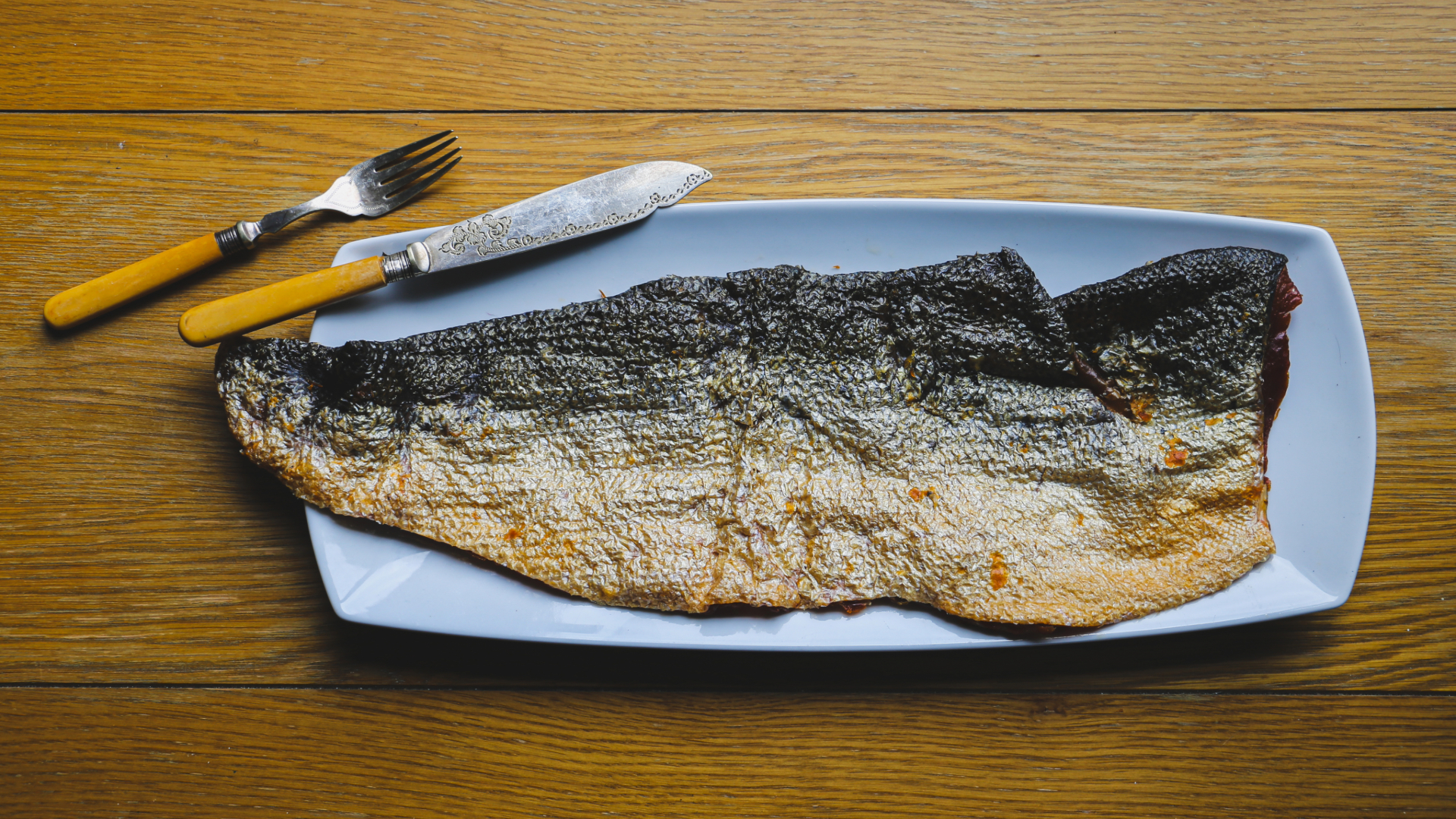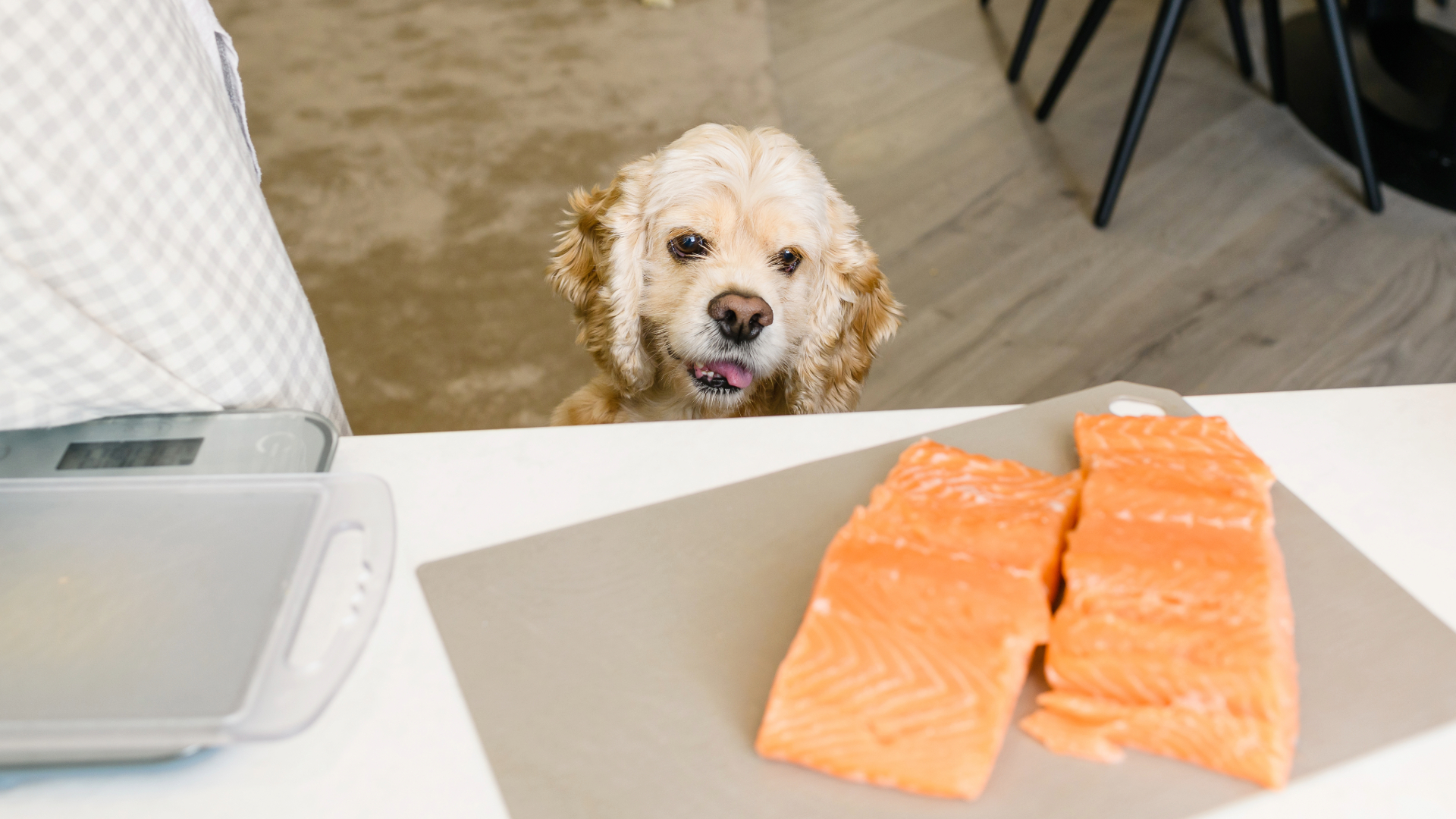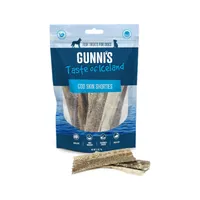Can dogs have fish skins? Here’s what a vet wants you to know
A vet reveals the pros and cons of fish skins for dogs

If you’ve ever found yourself thinking, “Can dogs have fish skin?” while preparing your favorite fish recipe for dinner, you’re not alone. With so much conflicting advice online about what's safe and what's not, it can be tricky to know whether it's OK to feed it to your dog.
Fish hide (made from fish skins) is actually one of the best long-lasting dog chews and is recommended by many vets as a safer alternative to rawhide. It's high in protein and omega-3s, which promote a healthy coat, skin, and brain – but it does come with one drawback you'll want to keep in mind.
Below, expert vets Dr Coder and Dr Pendergrass explain the pros, the cons, and how to feed fish skins safely to your dog. They’ve also shared their recommendations for the best types of fish and how much you can give your pet per day.
Can dogs have fish skin?
The good news is, fish skin is generally safe for dogs to eat, provided it's thoroughly cooked without any seasonings or ingredients like onions, oil, butter, and salt (which are one of the foods dogs should never eat).
Dr Pendergrass tells us that fish skin, just like the rest of the fish flesh, is loaded with numerous nutrients that could benefit your dog.
“Fish skin has many nutrients that promote good overall health, particularly omega-3 fatty acids. It is also high in protein, low in calories and saturated fats, and contains several minerals (zinc, iron, potassium, calcium) and vitamins,” she says.
However, raw or undercooked fish skins can be detrimental to your dog’s health.
Get the best advice, tips and top tech for your beloved Pets
According to Dr Coder, raw fish skin carries disease-causing bacteria, among them Salmonella, Listeria, and Clostridium. Eating raw or undercooked fish skin can make your dog seriously ill, which is why well-cooked fish skin is the safest choice for them.

👍Pros of fish skin
Promotes overall good health
According to Dr Coder, the major benefit of fish skin lies in its exceptionally high concentration of omega-3 fatty acids, which play a crucial role in your dog’s overall well-being.
“Fish skin is an excellent source of omega fatty acids for your dog. These nutrients play a role in hormone regulation, immunity, controlling inflammation, supporting brain and eye function, and skin health,” she says.
👎Cons of fish skin
High fat content
Since fish skin is naturally a fatty food, it can lead to digestive issues if consumed regularly in large amounts.
“The high fat content and omega fatty acid combination can change the absorption of your dog’s regular diet, as well as possibly upset their stomach,” explains Dr Coder.
Are fish skin chews safe for dogs?
“Most commercially available fish skin chews are safe and digestible for dogs,” says Dr. Coder.
Fish skin chews – also called fishhide – are not only safe for dogs due to their all-natural ingredients, but also beneficial to their dental health. The rough, chewy texture of fish skin chews helps break down built-up tartar and plaque, ultimately improving your dog’s dental hygiene.
Unfortunately, the same can’t be said about rawhide chews.
According to findings published in the Today’s Veterinary Practice journal, rawhide chews often contain chemically processed ingredients and different artificial additives. Unlike fish skin chews, rawhide chews are quite unsafe and indigestible for dogs.
Gunni's Cod Skin Shorties | Amazon
Made from sustainably sourced Icelandic cod, these fish skins were voted one of the best long-lasting dog chews by our tester, Paul. They're high in protein, low in fat, and help promote healthy teeth and gums.
What types of fish skin can dogs eat?
When considering what type of fish skin to give your dog, Dr Pendergrass advises sticking to fish varieties known for their low mercury levels. “The skin should come from fish that are likely to be low in mercury, including salmon, whitefish, cod, and catfish,” she says.
What types of fish skin should I not feed my dog?
It’s best to avoid feeding your dog fish skin from species prone to high mercury content.
“Pet parents should avoid feeding the skin from fish that are likely to contain high levels of mercury, including shark, swordfish, king mackerel, tilefish, and albacore tuna,” Dr Pendergrass says.
She also advises against regularly feeding your dog fish skin from fish raised in farms. This is because most fish farms put their fish on diets that mostly comprise industrial chemicals, antibiotics, and other synthetic additives.
Moreover, giving your dog fish skin from long-living fish species isn’t a good idea. Dr Coder shares: “Avoid any larger, longer-lived fish such as shark, swordfish, king mackerel, marlin, and large tuna like bluefin, as these fish can accumulate more toxins like mercury and polychlorinated biphenyls.”
As noted in the MSD Veterinary Manual, pets who ingest mercury from dietary sources over an extended period of time are at a high risk of developing mercury poisoning, which mostly affects the kidneys, brain, and muscles.

How to feed fish skin to dogs
If you’re thinking of introducing your pup to fish skin, there are two options you can try: dehydrated or fresh fish skin.
While dehydrated and fresh fish skin both offer the same nutritional benefits to dogs, dehydrated fish skin is a great alternative if you’re looking for a convenient treat for your pup. Dehydrated fish skin is simply fish skin that’s been thoroughly dried to prolong its shelf life. Thanks to the dehydration process, dehydrated fish skin is free from harmful parasites and bacteria that often thrive in moisture.
Dr Coder says: “Dehydrated fish skin is not essentially different from fresh fish skin, other than there is less moisture in dehydrated products, and they may be more stable to be stored longer. Most commercial dehydrated fish skins are ready-to-eat, meaning you can serve your pup right away without going through the hassle of cooking."
“Rather than preparing dehydrated fish skin, it can be purchased from companies such as The Honest Kitchen Beams, and Savory Prime Cod Skin Crunchy Bites. Dehydrated fish skin should also be free of seasonings and oil,” emphasizes Dr Pendergrass.

If you’d like to prepare dehydrated fish skin for your dog at home instead of buying it ready made, Dr Coder recommends using a food dehydrator or oven.
“Dehydrated fish skins can be prepared using a food dehydrator or cooked in an oven. You can dehydrate in a regular oven at around 150-200°F for 48 hours. The more meat and subcutaneous particles you leave attached to the skin, the longer it may take to completely dry.”
As for fresh fish skin, the preparation is pretty straightforward.
“You can remove the skin from the fish before or after cooking the fish itself,” explains Dr Coder. “Cook thoroughly without any salt, seasonings, or oil.” According to Dr Coder, freshly cooked fish skin should be fed within one to two days of preparation.
How much fish skin can dogs safely eat?
As with every other human food, moderation is key when it comes to feeding your pup fish skin. According to Dr Pendergrass, fish skin should only be fed as an occasional treat and shouldn’t replace your dog’s regular diet.
“Fish skin should be considered a treat or a food topper; treats should make up no more than 10% of a dog’s daily caloric intake,” she explains.
If you’re unsure about feeding your dog fish skin because of an underlying health issue they have, Dr Pendergrass recommends consulting your vet.
Want more expert advice? Read can dogs chew corn cobs, can dogs eat shrimp and what human food can dogs eat? Or, learn how to stop a dog from chewing on wood

Dr. Lisa Coder graduated from the University of Missouri in 2013. Since then, she has worked in many different types of clinics, from equine, to mixed animal, to ER. She even served a few years with the United States Department of Agriculture as a public health veterinarian. She loves all animals and strive to provide a safe, comfortable, and compassionate place for the people and pets who make up our community family. Dr. Lisa and her practice Vital Animal Veterinary Clinic serves the greater Sioux Falls, South Dakota area, with compassionate care for cats, dogs, small exotic mammals, and reptiles. She is currently pursuing board certification in both types of exotic medicine. She has an absolutely brilliant staff, who supports her love of learning, teaching, and endeavoring to continually improve.

Dr. Pendergrass is the owner and founder of JPen Communications, a medical communications company that specializes in pet owner education. For the past nearly 10 years, she has written hundreds of articles on various pet care topics, including nutrition, behavior, and dental care. Her articles have been featured on several pet-focused websites, such as PetMD, Healthy Paws Pet Insurance, Great Pet Care, and Business Insider.
Edited by Megan Milstead.
This page was last updated in June 2025 by Milkah Mullanda.

Milkah is a freelance writer based in Nairobi, Kenya, with a strong passion for all things dogs and cats. With over four years of writing experience, her work has appeared on popular websites such as DogTime, CatTime, and DoggySaurus.
Milkah graduated from the University of Embu (Kenya) in 2017 with a Bachelor's Degree in Agribusiness Management and opted to pursue her passion for writing just a year after graduating. She enjoys meeting the informational needs of pet owners, one insightful article at a time. When she's not stuck in a writing hole doing what she does best, you may find her in the kitchen perfecting a recipe, or catching up on a true-crime documentary.
One of her greatest joys is spending time with her beloved cat, Lucky, while serenading her softly with her not-so-great karaoke skills.

